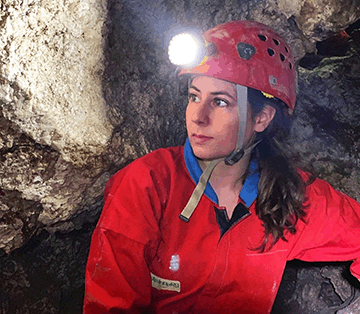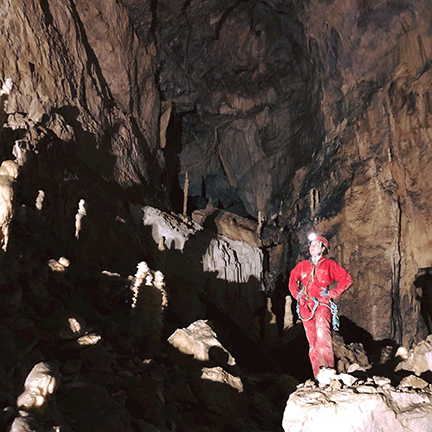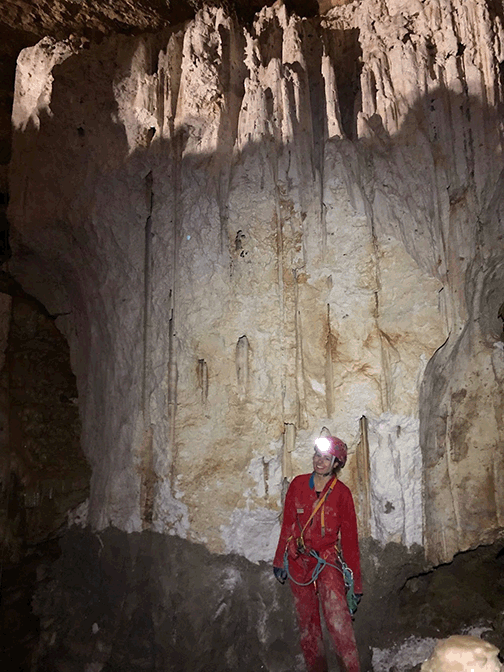NMT Grad Student Lands Competitive NASA ‘Future Investigator’ Grant
August 5, 2021
SOCORRO, N.M. – NMT Earth and Environmental Science graduate Student Zoë Havlena was recently awarded a prestigious NASA grant to fund her doctoral research in geomicrobiology.
 Her project is “Interpreting Acidic Gypsum Deposits as Hosts for Past and Present
Microbial Life.” Havlena (pictured at right) will be collecting and analyzing gypsum
samples from four cave systems in an effort to shed light on how life could grow in
harsh ecosystems, such as other planets or moons.
Her project is “Interpreting Acidic Gypsum Deposits as Hosts for Past and Present
Microbial Life.” Havlena (pictured at right) will be collecting and analyzing gypsum
samples from four cave systems in an effort to shed light on how life could grow in
harsh ecosystems, such as other planets or moons.
The FINESST award, or Future Investigators in NASA Earth and Space Science and Technology, is for graduate research proposals through the NASA Science Mission Directorate. Havlena’s proposal was funded through the Planetary Science division, which fielded 249 proposal applicants and only awarded 32 grants. The grant is for three years and will cover the remainder of her Ph.D. studies at New Mexico Tech.
Havlena is the “Future Investigator” and wrote the majority of the proposal, with guidance from her advisor Dr. Daniel Jones, who is the P.I. on the project. Jones is a faculty member in the Earth and Environmental Science Department and the Academic Director of the National Cave and Karst Research Institute, NMT’s division in Carlsbad.
 Havlena said gypsum is a mineral of interest in the search for life on Mars, since
the surface is thought to contain similar mineral deposits that formed from highly
acidic waters.
Havlena said gypsum is a mineral of interest in the search for life on Mars, since
the surface is thought to contain similar mineral deposits that formed from highly
acidic waters.
(At right: Zoe Havlena in the Frasassi Cave in Italy.)
“On Earth, we can study how biological material is preserved in similar acidic gypsum deposits and use this information to improve our understanding and ability to detect any evidence of extraplanetary life,” Havlena said. “Although we know that acid-tolerant “extreme” microbes help in the formation of gypsum in these systems, we don’t fully understand how they inhabit the gypsum itself or how well the evidence of their activity is preserved over geologic timescales.”
Astrobiologists have studied the microbes that inhabit gypsum crusts on the Earth surface, but there is also acidic gypsum in special cave systems known as sulfuric acid caves. These caves are ideal “natural laboratories” for research since the ecosystem within is supported by unique forms for life and is not subject to surface influences like photosynthesis. The NASA Astrobiology Strategy characterizes these kinds of subsurface environments as important targets for studying the kind of rock-hosted extreme life that may exist on other planets.
 Havlena will take samples from four cave systems: the Frasassi and Acquasanta caves
in Italy, Carlsbad Caverns in New Mexico, and Lehman Caves in Great Basin National
Park in Nevada. The Italian caves are one of the few locations in the world where
this sulfidic process is actively happening today, while the now inactive Carlsbad
Caverns formed several million years ago and retains “ancient” gypsum deposits. Lehman
Caves is theorized to have formed in a similar way and may be even older, potentially
up to 10 million years old.
Havlena will take samples from four cave systems: the Frasassi and Acquasanta caves
in Italy, Carlsbad Caverns in New Mexico, and Lehman Caves in Great Basin National
Park in Nevada. The Italian caves are one of the few locations in the world where
this sulfidic process is actively happening today, while the now inactive Carlsbad
Caverns formed several million years ago and retains “ancient” gypsum deposits. Lehman
Caves is theorized to have formed in a similar way and may be even older, potentially
up to 10 million years old.
(At right: Zoe Havlena in front of an underground gypsum deposit.)
“The timescale of gypsum ages from these systems is a key part in developing our understanding of how well this mineral may or may not preserve evidence of life,” Havlena said.
This project will use a multidisciplinary approach involving microbiology and molecular biology, organic geochemistry, and mineralogical analyses. She will work with collaborators at NASA’s Goddard Spaceflight Center to search for biomarkers, which are special biological compounds that may last in the environment for a long period of time.
“The information I obtain from this project will hopefully transform our understanding of how life uses acidic gypsum on Earth, and how it may do so on Mars or other planets,” she said.
Havlena was born in Albuquerque and grew up in Madison, Wisc. She returned to New Mexico for college and got her bachelor's in biology at NMT in 2017, followed by her master's in biology in 2019. Her master’s research was on a project in Carlsbad Caverns with advisor Dr. Tom Kieft. The manuscript from her master’s work was published in early 2021 in Applied and Environmental Microbiology (https://journals.asm.org/doi/full/10.1128/AEM.02695-20). She is also an Incident Commander for New Mexico Search and Rescue.
– NMT –